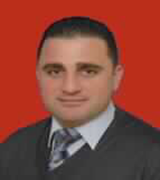Clinical Pharmacy and Practice
Permanent URI for this collection
Overview
Use of HbA1c to diagnose type 2 diabetes Mellitus. Gestational diabetes and adverse pregnancy outcome is under investigation. Type 2 diabetes in children will be investigated in schools. A platform will be developed to follow up risk factors like obesity, lack of exercise, unhealty food and genetics. The program will highlight the risk factors for each students to be used by parents, Ministry of Education, Ministry of Health and School administration to overcome these risk factors and to treat those who developed diabetes.
Our Team
Browse
Recent Submissions
- ItemPharmacovigilance and Adverse Drug Reactions Reporting Process in West-Bank, Palestine(Deanship of Scientific Research at An Najah National University, 2016-10-09) Khdour, Maher; Yaghmour, Nima; Hallak, Hussein; Dweib, Mohammad; Al-Shahed, Qusai; Jarab, AnanActive national pharmacovigilance programmes are needed to monitor adverse drug reaction (ADR) data in local populations. The objective of this study was to describe the knowledge, experiences, attitudes and perceived barriers to reporting of suspected ADRs by community and hospital pharmacists in West Bank, Palestine. Between December 2014 and March 2015 we conducted a survey about the knowledge and attitude of pharmacists (n = 270) using a face-to-face questionnaire. The questionnaire consisted of questions about the sociodemographic characteristics of the pharmacists, their knowledge of pharmacovigilance and their attitudes towards ADR reporting. Main outcomes measured: The majority of the pharmacists (62.6%) worked in the community pharmacies and more females responded to the questionnaire than males (59% vs 41%). only 11.9% could conceptually or actually define ‘pharmacovigilance’ correctly while one quarter of the respondent pharmacist (24.9%) could define ADR correctly. The hospital clinical pharmacists defined ‘pharmacovigilance’ correctly with higher significance (P<0.001) when compared with community pharmacists. Only 12.2% had ever reported an ADR. The majority of these reports (85%) done by the hospital pharmacists (p<0.0001). The main reasons that discourage the pharmacists from reporting ADRs were ‘‘no enough information available from the patient (76.7%)’’, and ‘‘they did not know how to report (66.7%)’’. The majority of the respondents (92.0%) felt that reporting ADR was their duty and (82%) participants were interested in participating in the National Pharmacovigilance Programme in Palestine. The results show that Palestinian pharmacists have poor knowledge about pharmacovigilance. There is an urgent need for educational programs to train them about pharmacovigilance and ADR reporting scheme.
- ItemPharmacists’ Knowledge, Attitudes and Practices Towards Herbal Remedies In West Bank, Palestine(International Medical Society, 2016-06-03) Khdour, Maher R.; Kurdi, Manar; Hallak, Hussein O.; Jarab, Anan S.; Dweib, Mohammad; Al-Shahed, Qusai N.Background: There is an increasing trend towards consumption of complementary and alternative herbal products in many parts of the world. Objectives: The purpose of this study was to investigate the knowled - ge and attitudes among pharmacists in West Bank, Palestine towards the use of herbs. Methods: Self-administered questionnaire was designed as the study instrument and distributed among 350 qualified pharmacists working in government and private pharmacies in West Bank, Palestine. Results: The response rate was 82.9% (290/350). The mean age of the pharmacists was 32.9 (SD=6.5) years. The majority of the phar - macist 238 (82.1%) worked in the community pharmacies and their experience in practice ranged from 1 to 26 years. Product package instructions and product representative were the most consulted by the pharmacists (128; 44.2% and 73; 25.2% respectively). General health tonic preparations were the most widely dispensed drugs (142; 48.9%), followed by cough preparations (55; 19.0%) and slimming agents (64; 22.1%). The Majority of pharmacists (195; 67.2%) belie - ved herbal remedies were effective; however, about fifty percent of the pharmacists had concern about their safety. The knowledge of respondents about the indications of herbal medicine was good, but their awareness of interactions, contraindications and adverse effects was inadequate. The majority of Pharmacists (255; 87.9%) believed that herbal product should undergo increased regulation and (215; 74.9%) believed that information available about herbal and natural product isn't adequate.
- ItemAssessment of Patient Safety Culture in the Palestinian Hospital Pharmacies(AL-Quds University, 2011) وفاء جمال حسن الزغاري; Wafa Jamal Hassan Zaghari; معتصم حمدان; Hussein Hallak; Ali ShaarBackground: Patient safety culture assessment in pharmacies is increasing largely worldwide, many tools that were used to assess patient safety culture at the hospital settings as a whole are now adapted to be used for pharmacies. One of the most commonly used and rigorously validated tools to measure patient safety culture is the Safety Attitudes Questionnaire (SAQ). The tool consists of 30 items that cover six safety culture domains. The intention of this research is to map the patient safety culture in the Palestinian hospital pharmacies, this will be achieved through measuring and analyzing the patient safety culture domains there, understanding factors influencing safety culture and examine variations between different hospital pharmacies. This assessment helps in determining safety culture domains that are considered as areas of strength, and safety culture domains that are considered as areas of weakness for each hospital pharmacy. Mapping patient safety culture in hospital pharmacies will end up by directing each hospital pharmacy to improve areas of weakness effectively and efficiently. Purpose: To assess patient safety culture in the Palestinian hospital pharmacies, and to assess the association of hospitals and respondents characteristics with patient safety culture. Methods: A cross-sectional design was used. The English version of the SAQ was translated and adapted to the Palestinian context. The survey was carried out in (28) Palestinian hospitals in the West Bank and East Jerusalem. All pharmacist assistants, pharmacist, and clinical pharmacists in these hospitals were targeted, estimated to 115 personnel. Items mean and scale scores were calculated. Then a composite score equivalent to the arithmetic mean of the scale scores were also calculated. In order to identify areas of strength and areas for potential improvement, the percentages of positive responses for the survey domains and items were calculated. Univariate analysis was used to test associations between composite patient safety scores and different respondent and hospital characteristics. viii Findings: 73 persons participated in the study, response rate was 68.8%. Females were 66.7%, 51% were pharmacist or clinical pharmacist, and 84.7% were with experience ≥ 5 years in profession. Two SAQ domains, job satisfaction and working conditions, were identified as areas of strength and received ≥75% of positive responses. Patient safety level was graded as “accepted” by (50%) of the respondents and none gave their pharmacy a “Poor” or “Failing” grade. Event reporting was very low, (66%) of the respondents didn’t report any event in the past year. In regard to the associations between safety culture domains scores with participants and hospital characteristics, the association was statistically significant (P<0.05) in regard to hospital ownership with the teamwork climate (P=0.02), perception of management (P=0.03), job satisfaction (P=0.001), and working conditions (P=0.02) and all in favor of the private and NGO hospitals. Participants working in hospitals sized <50 beds were more positive towards perception of management climate than their counterparts in larger sized hospitals (P=0.031). The overall safety score was significantly associated only with the hospital ownership (P=0.002) in favor of the private and NGO hospitals. No statistically significant associations were found between safety culture domains and the participant’s age, gender, years of experience in profession and hospital, level of education, working hours, and job title. The safety culture domain scores varied largely among different hospital pharmacies. None of the six domains were positive for four hospitals, twelve hospitals have negative total safety score and the best result was having five positive safety domains and a positive total safety score and this result was achieved only by two hospitals. Conclusions: Safety culture assessment results revealed areas for potential improvement in Palestinian hospital pharmacies. Hospitals need to formulate specific patient safety culture interventions to address these weaknesses
- ItemCost-utility analysis of a pharmacy-led self-management programme for patients with COPD(Springer Science+Business Media B.V. 2011, 2011-06-04) Khdour, Maher R.; Agus, Ashley M.; Kidney, Joseph C.; Smyth, Bronagh M.; Elnay, James C.; Crealey, Grainne E.Objective: To undertake a cost-utility analysis (CUA) of a pharmacy-led self-management programme for Chronic Obstructive Pulmonary Disease (COPD). Setting: A single outpatient COPD clinic at the Mater Hospital, Belfast, Northern Ireland between. Method: CUA alongside a randomised control trial. The economic analysis used data from 127 COPD patients aged over 45 years, with an FEV1 of 30–80% of the predicted normal value. Participants received either a pharmacy-led education and selfmanagement programme, or usual care. One year costs were estimated from the perspective of the National Health Service and Personal Social Services and quality-adjusted life years (QALYs) were calculated based on responses to the EQ-5D at baseline, 6 and 12 months. Main outcome measure: Cost per QALY gained. Results: The mean differences in costs and effects between the self-management and education programme and usual care were -£671.59 (95 CI%: -£1,584.73 to -£68.14) and 0.065 (95% CI; 0.000–0.128). Thus the intervention was the dominant strategy as it was both less costly and more effective than usual care. The probability of the intervention being costeffective was 95% at a threshold of £20,000/QALY gained. Sensitivity analyses indicated that conclusions were robust to variations in most of the key parameters. Conclusion: The self-management and education programme was found to be highly cost-effective compared to usual care. Further research is required to establish what aspects of self-management and education programmes have the greatest impact on cost-effectiveness.
- ItemSocietal perspectives on community pharmacy services in West Bank - Palestine(2012-03-12) Khdour, Maher R.; Hallak, Hussein O.Understanding the public's view of professional competency is extremely important; however little has been reported on the public’s perception of community pharmacists in Palestine Objectives: To determine the perception of Palestinian consumers of the community pharmacist and the services they offer Method: This project used the survey methodology administered by structured interviews to consumers who attended the 39 randomly selected pharmacies, in six main cities in Palestine. The questionnaire had range of structured questions covering: Consumers’ patronage patterns, consumers’ interaction with community pharmacists, consumers’ views on how the pharmacist dealt with personal health issues, procedure with regard to handling private consultations. Results: Of 1,017 consumers approached, 790 consumers completed the questionnaire (77.7 %). Proximity to home and presence of knowledgeable pharmacist were the main reasons for patients to visit the same pharmacy. Physicians were identified as the preferred source of advice by 57.2% and pharmacists by 23.8%. Only 17% of respondents considered pharmacists as health professionals who know a lot about drugs and are concerned about and committed to caring for the public. In addition, 49% indicated that pharmacists spoke more quietly cross the counter during counseling and almost one third reported that the pharmacist used a private area within the pharmacy. The majority of respondents would be happy to receive different extended services in the community pharmacy like blood pressure monitoring. Conclusions: Palestinian consumers have a positive overall perception of community pharmacists and the services they offer. Awareness should be created amongst the public about the role of pharmacist and the added value they can provide as health care professional. There is a need to consider privacy when giving patient counseling to increase user satisfaction.



